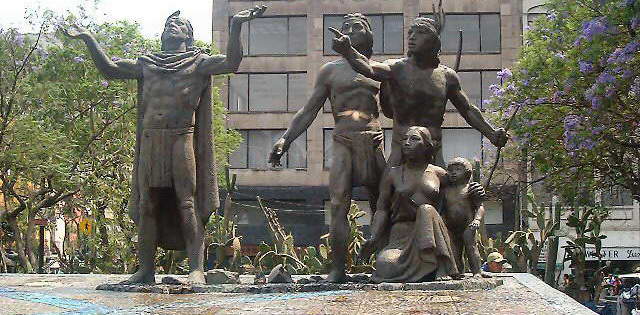Tenochtitlan
Tenochtitlan or, alternatively, Mexico-Tenochtitlan, was the capital of the Aztec empire, which was built on an island in Lake Texcoco in what is now central Mexico. The city was largely destroyed in the 1520s by Spanish conquistadors, Mexico City was erected on top of the ruins and, over the ensuing centuries, most of Lake Texcoco has gradually been drained.
Many different tribes came and went from the shores of the lake without establishing a permanent, important culture. It was not until the arrival of the Aztecs, a tribe of people who came in from the west, that the area acquired its importance.

Statue in Mexico City celebrating the founding of Tenochtitlan
The Aztecs migrated following an ancient legend that prophesied that they would find the site for their new city in a place where they would see a mythical vision fulfilled: an eagle eating a snake while perched atop a cactus. The Aztecs eventually came across this vision on what was then a small swampy island in Lake Texcoco. Not deterred by the unfavourable terrain, they invented the chinampa system to dry the land by setting up small plots in which they produced all the food they required. When enough land was dry they would begin to build there. Tenochtitlan (the Nahuatl language name for the city) was founded in 1325.
A thriving culture developed, and the Aztec empire came to dominate other tribes all around Mexico. The small natural island was perpetually enlarged as an artificial island as Tenochtitlan grew to become the largest and most powerful city in Mesoamerica. Commercial routes were developed that brought goods from places as far as the Gulf of Mexico, the Pacific Ocean and perhaps even the Inca Empire.
The city was connected to the mainland by a series of wide causeways with bridges. The city was interlaced with a series of canals, so that all sections of the city could be visited either on foot or via canoe.
After a flood of Lake Texcoco, the city was rebuilt in a style that made it one of the grandest ever in Mesoamerica under Emperor Auitzotl.

Map of Tenochtitlan, Mural painting from the National Museum of Anthropology, Mexico City. Painted in 1930 by Dr. Atl.
Spanish conquistador Hernán Cortés arrived in Tenochtitlan on November 8, 1519. At this time it is believed that the city was amongst the largest in the world alongside Paris and Constantinople. The most common estimates put the population at around 200,000 to 300,000 people. Aztec ruler Moctezuma II, thinking Cortés to be the returning god Quetzalcoatl, welcomed him with great pomp. Some of the conquistadors had traveled as widely as Venice and Constantinople, and many said that Tenochtitlan was as large and fine a city as any they had seen.
Cortés and his men eventually conquered the city on August 13, 1521, after a struggle that lasted months in which much of the city was destroyed. The rest of the city was either destroyed, dismantled or buried as Mexico City was built on top of it.
All text is available under the terms of the GNU Free Documentation License.